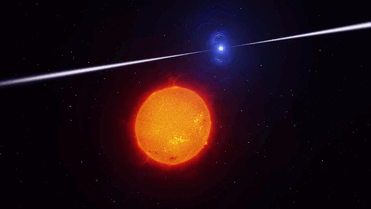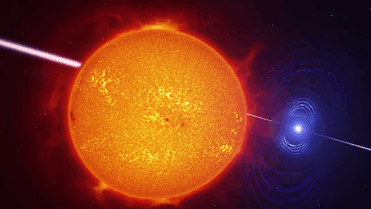🐱:(source)










🐱:(source)
More Posts from Ocrim1967 and Others










This Is What We Know About Black Holes In Advance Of The Event Horizon Telescope’s First Image
“For hundreds of years, humanity has expected black holes to exist. Over the course of all of our lifetimes, we’ve collected an entire suite of evidence that points not only to their existence, but to a fantastic agreement between their expected theoretical properties and what we’ve observed. But perhaps the most important prediction of all — that of the event horizon’s existence and properties — has never been directly tested before.
With simultaneous observations in hand from hundreds of telescopes across the globe, scientists have finished reconstructing an image, based on real data, of the largest black hole as seen from Earth: the 4 million solar mass monster at the center of the Milky Way. What we’ll see on April 10 will either further confirm General Relativity or cause us to rethink all that we believe about gravity. Eager with anticipation, the world now awaits.”
The Event Horizon Telescope will, on April 10 (tomorrow, at the time of this writing), release an image two years in the making: of the event horizon of the black hole at the Milky Way’s center. Many will look at this as the first definitive proof that black holes truly exist, but we mustn’t forget all the (overwhelming!) evidence we already have in hand. There is a ton that we already know about black holes that has been demonstrated observationally, and all of it is in spectacular agreement with what we theoretically expect.
On the eve of the Event Horizon Telescope’s big announcement, take some time to get a little perspective, and learn what we already know about black holes!










He faced all this for you, for you to be loved, blessed, glorified, exalted, satisfied, accepted, freed and resurrected.








Asperitas and Mammatus
Well-defined, wave-like structures in the underside of the cloud; more chaotic and with less horizontal organization than the variety undulatus. Asperitas is characterized by localized waves in the cloud base, either smooth or dappled with smaller features, sometimes descending into sharp points, as if viewing a roughened sea surface from below. Varying levels of illumination and thickness of the cloud can lead to dramatic visual effects.
Occurs mostly with Stratocumulus and Altocumulus
Mammatus is a cellular pattern of pouches hanging underneath the base of a cloud, typically cumulonimbus rainclouds, although they may be attached to other classes of parent clouds.
source | source | images: x, x, x, x, x, x, x
Cosmic rays
Cosmic rays provide one of our few direct samples of matter from outside the solar system. They are high energy particles that move through space at nearly the speed of light. Most cosmic rays are atomic nuclei stripped of their atoms with protons (hydrogen nuclei) being the most abundant type but nuclei of elements as heavy as lead have been measured. Within cosmic-rays however we also find other sub-atomic particles like neutrons electrons and neutrinos.

Since cosmic rays are charged – positively charged protons or nuclei, or negatively charged electrons – their paths through space can be deflected by magnetic fields (except for the highest energy cosmic rays). On their journey to Earth, the magnetic fields of the galaxy, the solar system, and the Earth scramble their flight paths so much that we can no longer know exactly where they came from. That means we have to determine where cosmic rays come from by indirect means.

Because cosmic rays carry electric charge, their direction changes as they travel through magnetic fields. By the time the particles reach us, their paths are completely scrambled, as shown by the blue path. We can’t trace them back to their sources. Light travels to us straight from their sources, as shown by the purple path.

One way we learn about cosmic rays is by studying their composition. What are they made of? What fraction are electrons? protons (often referred to as hydrogen nuclei)? helium nuclei? other nuclei from elements on the periodic table? Measuring the quantity of each different element is relatively easy, since the different charges of each nucleus give very different signatures. Harder to measure, but a better fingerprint, is the isotopic composition (nuclei of the same element but with different numbers of neutrons). To tell the isotopes apart involves, in effect, weighing each atomic nucleus that enters the cosmic ray detector.

All of the natural elements in the periodic table are present in cosmic rays. This includes elements lighter than iron, which are produced in stars, and heavier elements that are produced in violent conditions, such as a supernova at the end of a massive star’s life.

Detailed differences in their abundances can tell us about cosmic ray sources and their trip through the galaxy. About 90% of the cosmic ray nuclei are hydrogen (protons), about 9% are helium (alpha particles), and all of the rest of the elements make up only 1%. Even in this one percent there are very rare elements and isotopes. Elements heavier than iron are significantly more rare in the cosmic-ray flux but measuring them yields critical information to understand the source material and acceleration of cosmic rays.

Even if we can’t trace cosmic rays directly to a source, they can still tell us about cosmic objects. Most galactic cosmic rays are probably accelerated in the blast waves of supernova remnants. The remnants of the explosions – expanding clouds of gas and magnetic field – can last for thousands of years, and this is where cosmic rays are accelerated. Bouncing back and forth in the magnetic field of the remnant randomly lets some of the particles gain energy, and become cosmic rays. Eventually they build up enough speed that the remnant can no longer contain them, and they escape into the galaxy.

Cosmic rays accelerated in supernova remnants can only reach a certain maximum energy, which depends on the size of the acceleration region and the magnetic field strength. However, cosmic rays have been observed at much higher energies than supernova remnants can generate, and where these ultra-high-energies come from is an open big question in astronomy. Perhaps they come from outside the galaxy, from active galactic nuclei, quasars or gamma ray bursts.

Or perhaps they’re the signature of some exotic new physics: superstrings, exotic dark matter, strongly-interacting neutrinos, or topological defects in the very structure of the universe. Questions like these tie cosmic-ray astrophysics to basic particle physics and the fundamental nature of the universe. (source)
The Summer Solstice Has Arrived!
This year’s summer solstice for the northern hemisphere arrives at 11:54 a.m. EDT, meaning today is the longest day of the year! The number of daylight hours varies by latitude, so our headquarters in Washington, D.C. will see 14 hours, 53 minutes, and 51 seconds of daylight. A lot can happen in that time! Let’s find out more.

If you’re spending the day outside, you might be in the path of our Earth Science Satellite Fleet (ESSF)! The fleet, made up of over a dozen Earth observation satellites, will pass over the continental United States about 37 times during today’s daylight hours.

These missions collect data on atmospheric chemistry and composition, cloud cover, ocean levels, climate, ecosystem dynamics, precipitation, and glacial movement, among other things. They aim to do everything from predicting extreme weather to helping informing the public and decision makers with the environment through GPS and imaging. Today, their sensors will send back over 200 gigabytes (GB) of data back to the ground by sunset.

As the sun sets today, the International Space Station (ISS) will be completing its 10th orbit since sunrise. In that time, a little more than 1 terabyte-worth of data will be downlinked to Earth.

That number encompasses data from ground communications, payloads, experiments, and control and navigation signals for the station. Approximately 330 GB of that TB is video, including live broadcasts and downlinks with news outlets. But as recently-returned astronaut Serena Auñón-Chancellor likes to point out, there’s still room for fun. The astronauts aboard the ISS can request YouTube videos or movies for what she likes to call “family movie night.”

Astronauts aboard the station also send back images—LOTS of them. Last year, astronauts sent back an average of 66,912 images per month! During today’s long hours of daylight, we expect the crew to send back about 656 images. But with Expedition 59 astronauts David Saint-Jacques (CSA), Anne McClain (NASA), and Oleg Kononenko (RKA) hard at work preparing to return to Earth on Monday, that number might be a little less.

Say you’re feeling left out after seeing the family dinners and want to join the crew. Would you have enough daylight to travel to the ISS and back on the longest day of the year? Yes, but only if you’re speedy enough, and plan your launch just right. With the current fastest launch-to-docking time of about six hours, you could complete two-and-a-half flights to the ISS today between sunrise and sunset.

When returning from orbit, it’s a longer ordeal. After the Expedition 59 trio arrives on Earth Monday night, they’ll have to travel from Kazakhstan to Houston to begin their post-flight activities. Their journey should take about 18 hours and 30 minutes, just a few hours longer than the hours of daylight we’ll see today.

Happy solstice! Make sure to tune in with us on Monday night for live coverage of the return of Expedition 59. Until then, enjoy the longest day of the year!
Make sure to follow us on Tumblr for your regular dose of space: http://nasa.tumblr.com.

Pulsar planets are planets that are found orbiting pulsars, or rapidly rotating neutron stars. The first such planet to be discovered was around a millisecond pulsar and was the first extrasolar planet to be confirmed as discovered.
source


The Scorpii AR system
In the system AR Scorpii a rapidly spinning white dwarf star powers electrons up to almost the speed of light. These high energy particles release blasts of radiation that lash the companion red dwarf star, and cause the entire system to pulse dramatically every 1.97 minutes with radiation ranging from the ultraviolet to radio.
The star system AR Scorpii, or AR Sco for short, lies in the constellation of Scorpius, 380 light-years from Earth. It comprises a rapidly spinning white dwarf, the size of Earth but containing 200,000 times more mass, and a cool red dwarf companion one third the mass of the Sun, orbiting one another every 3.6 hours in a cosmic dance as regular as clockwork.
Read more at: cosmosmagazine & astronomynow
What’s Up For September 2018?
Outstanding views Venus, Jupiter, Saturn and Mars with the naked eye!

You’ll have to look quickly after sunset to catch Venus. And through binoculars or a telescope, you’ll see Venus’s phase change dramatically during September - from nearly half phase to a larger thinner crescent!

Jupiter, Saturn and Mars continue their brilliant appearances this month. Look southwest after sunset.

Use the summer constellations help you trace the Milky Way.

Sagittarius: where stars and some brighter clumps appear as steam from the teapot.

Aquila: where the Eagle’s bright Star Altair, combined with Cygnus’s Deneb, and Lyra’s Vega mark the Summer Triangle.

Cassiopeia, the familiar “w”- shaped constellation completes the constellation trail through the Summer Milky Way. Binoculars will reveal double stars, clusters and nebulae.

Between September 12th and the 20th, watch the Moon pass from near Venus, above Jupiter, to the left of Saturn and finally above Mars!

Both Neptune and brighter Uranus can be spotted with some help from a telescope this month.

Look at about 1:00 a.m. local time or later in the southeastern sky. You can find Mercury just above Earth’s eastern horizon shortly before sunrise. Use the Moon as your guide on September 7 and 8th.

And although there are no major meteor showers in September, cometary dust appears in another late summer sight, the morning Zodiacal light. Try looking for it in the east on moonless mornings very close to sunrise. To learn more about the Zodiacal light, watch “What’s Up” from March 2018.

Watch the full What’s Up for September Video:
There are so many sights to see in the sky. To stay informed, subscribe to our What’s Up video series on Facebook.
Make sure to follow us on Tumblr for your regular dose of space: http://nasa.tumblr.com










Ask Ethan: Is There A Fundamental Reason Why E = mc²?
“Einstein’s equation is amazingly elegant. But is its simplicity real or only apparent? Does E = mc² derive directly from an inherent equivalence between any mass’s energy and the square of the speed of light (which seems like a marvelous coincidence)? Or does the equation only exist because its terms are defined in a (conveniently) particular way?”
Quite arguably, Einstein’s E = mc² is the most famous equation in the entire world. And yet, it isn’t obvious why it had to be this way! Could there have been some other speed besides the speed of light that converts mass to energy? Could there have been a multiplicative constant out in front besides “1” to give the right answer? No, no there couldn’t. If energy and momentum are conserved, and particles have the energies and momenta that they do, there’s no other option.
Come learn, at last, why E = mc², and why simply no other alternative will do.
-
 kiki42o69 reblogged this · 5 months ago
kiki42o69 reblogged this · 5 months ago -
 mohamed-577-kamar liked this · 6 months ago
mohamed-577-kamar liked this · 6 months ago -
 wildernestt reblogged this · 1 year ago
wildernestt reblogged this · 1 year ago -
 h47r3d liked this · 1 year ago
h47r3d liked this · 1 year ago -
 thelikesoftravis liked this · 1 year ago
thelikesoftravis liked this · 1 year ago -
 nimitwinklesims liked this · 1 year ago
nimitwinklesims liked this · 1 year ago -
 theadmiralwho liked this · 1 year ago
theadmiralwho liked this · 1 year ago -
 javi2211 reblogged this · 1 year ago
javi2211 reblogged this · 1 year ago -
 javi2211 liked this · 1 year ago
javi2211 liked this · 1 year ago -
 myrhaernyriaus liked this · 1 year ago
myrhaernyriaus liked this · 1 year ago -
 pabnorm reblogged this · 1 year ago
pabnorm reblogged this · 1 year ago -
 kii1l liked this · 2 years ago
kii1l liked this · 2 years ago -
 iamsancho reblogged this · 2 years ago
iamsancho reblogged this · 2 years ago -
 iamsancho liked this · 2 years ago
iamsancho liked this · 2 years ago -
 visgar12 liked this · 2 years ago
visgar12 liked this · 2 years ago -
 inkedhigh reblogged this · 2 years ago
inkedhigh reblogged this · 2 years ago -
 the-bearwitch reblogged this · 3 years ago
the-bearwitch reblogged this · 3 years ago -
 arrancione liked this · 3 years ago
arrancione liked this · 3 years ago -
 molly-mature571585-blog liked this · 3 years ago
molly-mature571585-blog liked this · 3 years ago -
 helloforgottenlibrary liked this · 3 years ago
helloforgottenlibrary liked this · 3 years ago -
 aniiy-17 liked this · 3 years ago
aniiy-17 liked this · 3 years ago -
 thedontknowdontcare reblogged this · 3 years ago
thedontknowdontcare reblogged this · 3 years ago